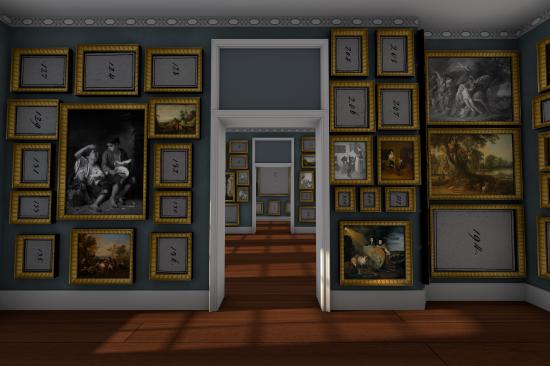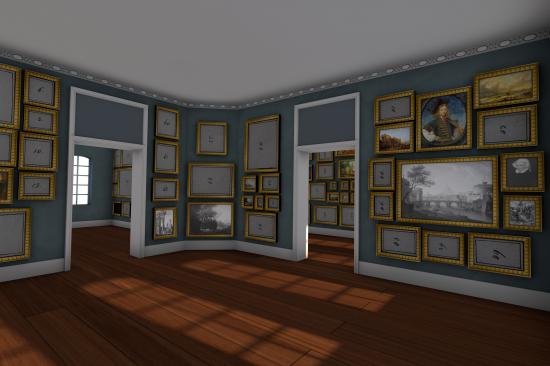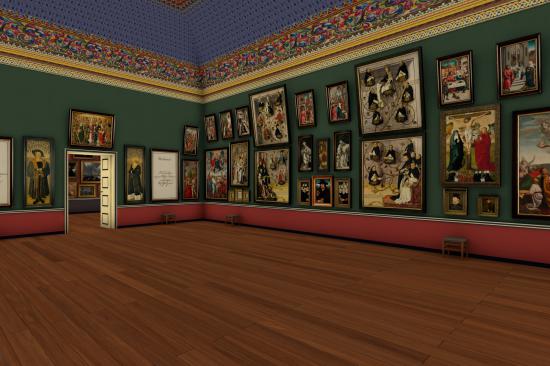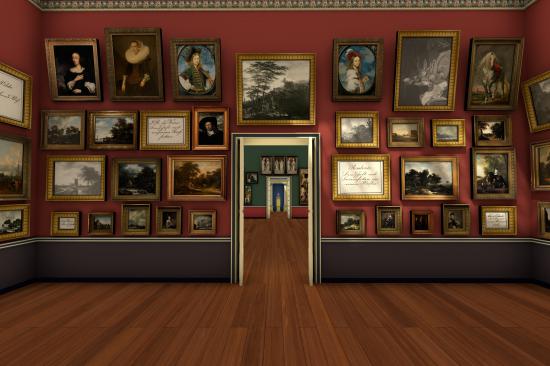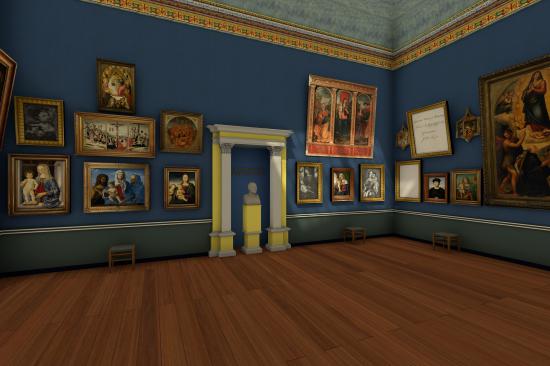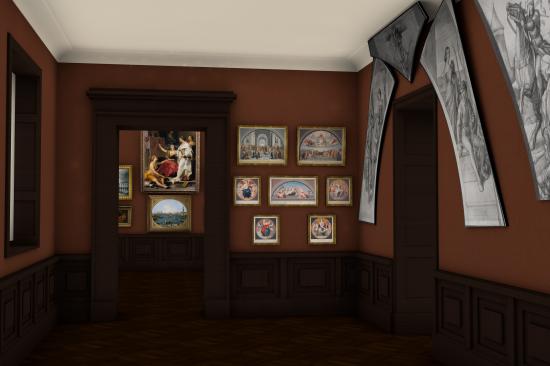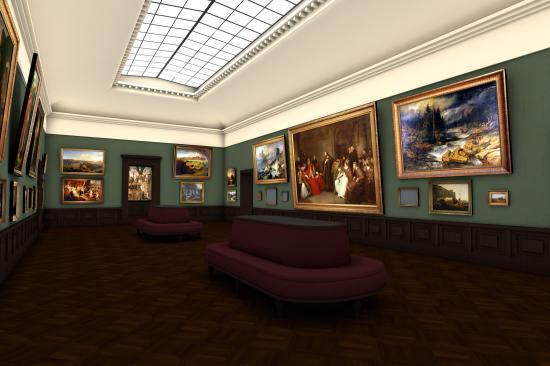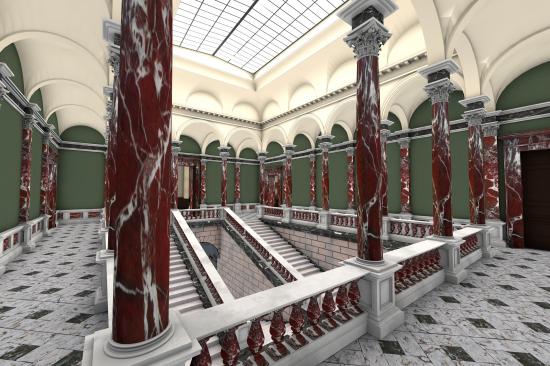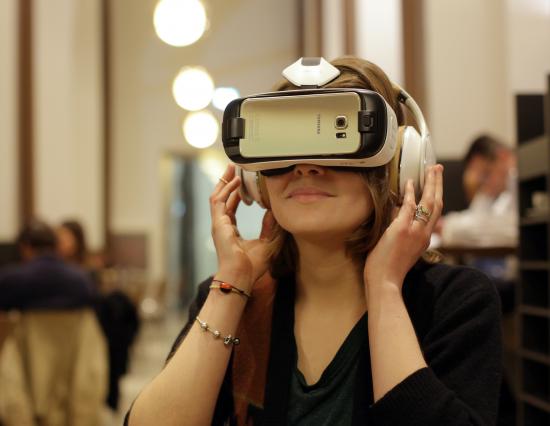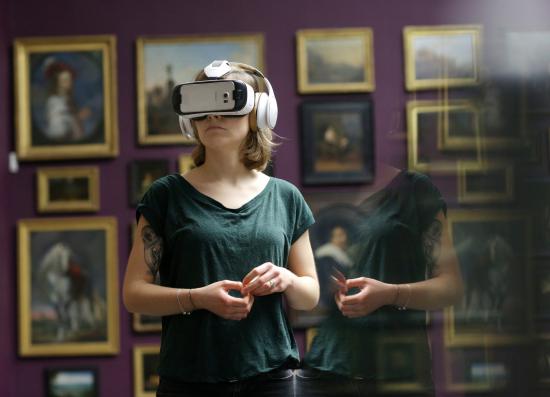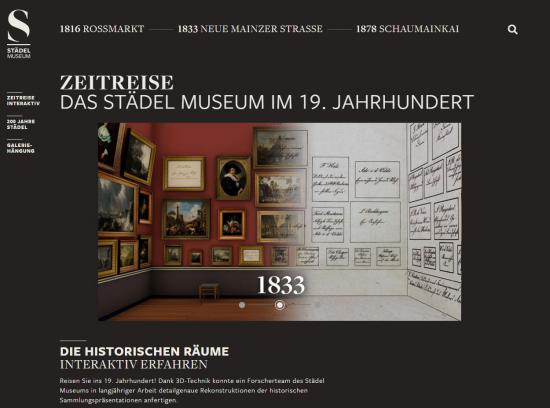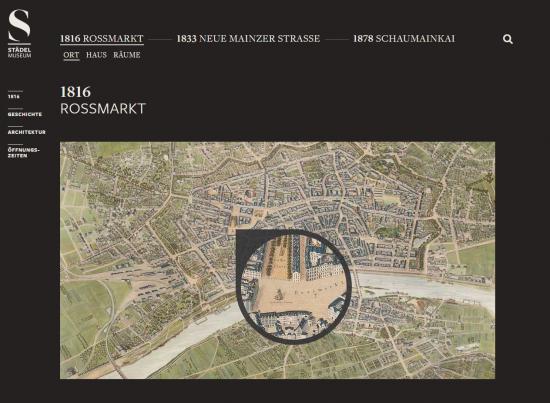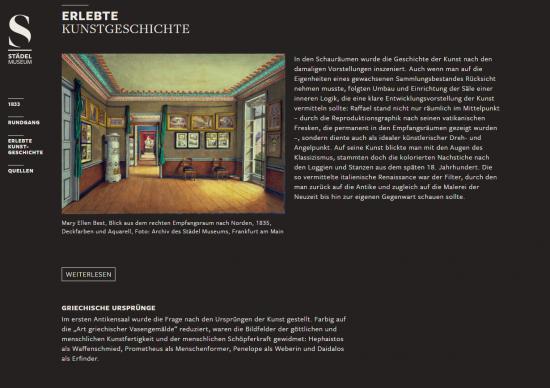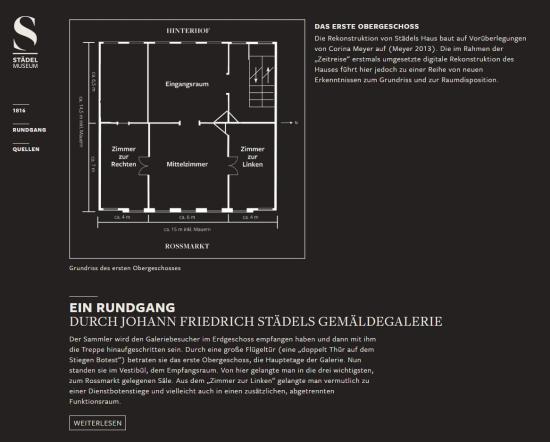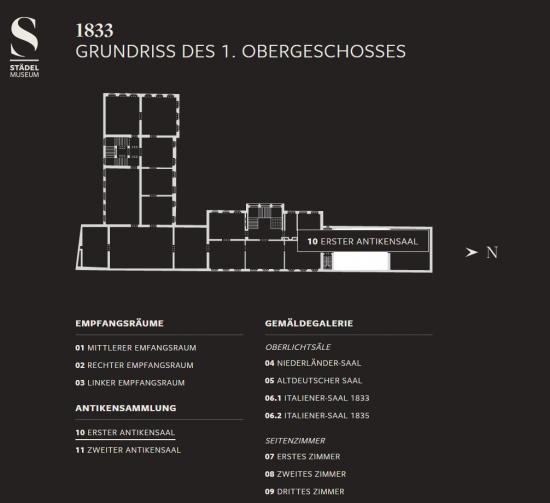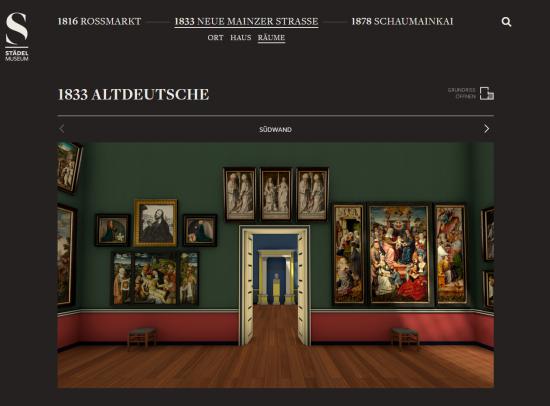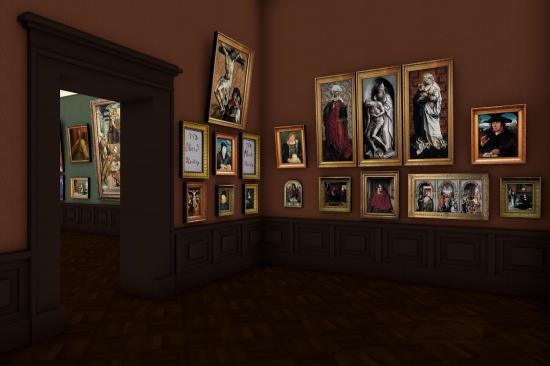As of today, the historical locations of the Städel Museum in the years 1816, 1833, and 1878, the respective presentations of the collection, and the works on display then can be viewed and relived online. The results of long-term research and reconstruction work on the history of collecting at the Städel Museum and the different forms of its holdings’ presentation in the nineteenth century are now freely accessible at zeitreise.staedelmuseum.de. Another way of experiencing the research results virtually live is to download the app developed especially for the mobile virtual reality headset “Samsung Gear VR” from the Oculus Store.
The website of the research project realised under Jochen Sander, Head of German, Dutch and Flemish Paintings before 1800, offers accurate and detailed 3D reconstructions of the presentation of the Städel’s collection at its three locations. Both the museum founder Johann Friedrich Städel’s private house on Rossmarkt of 1816 and the palace on Neue Mainzer Strasse, the first actual museum building accommodating the collection from 1833 on, were elaborately reconstructed. The new building on Schaumainkai, which opened its doors in 1878 and has been home to the museum to this day, and its original presentation are also part of the journey through time. The website includes in-depth information on the provenance of all paintings belonging to the collection at the respective points in time, details on the history of sales and losses, relevant inventory entries, and texts from selected nineteenth-century catalogues. Entries from scholarly catalogues presenting the collection’s holdings shed light on the current state of research. The website also offers a virtual tour through the interior of the rooms on Schaumainkai as they presented themselves in 1878. One may take this tour by using either a programme for personal computers or an app for the virtual reality headset “Samsung Gear VR,” which provide completely new insights.
This ground-breaking project shows how the most recent technological developments may be used for the generation and presentation of art-historical research results concerning an institution’s history of collecting and exhibiting its holdings in an appealing and beneficial manner. This contemporary and freely accessible presentation of research addresses both experts and interested lay people.
“The analysis of historical collection contexts has become a central scholarly issue. Revealing, not least, how tied to a particular period our perception of artworks is, the digital visualisation of how the Städel Museum presented its holdings in the nineteenth century is the first reconstruction of its kind that concerns an important civic collection,” Dr. Jochen Sander, deputy Director of the Städel, Head of German, Dutch and Flemish Paintings before 1800, and head of the research project, points out.
The VR implementation of the project “Time Machine. The Städel Museum in the Nineteenth Century” has been made possible by Samsung Electronics, Corporate Partner of the Städel Museum. The research project could be realised with additional support from the Foundation Polytechnische Gesellschaft Frankfurt am Main.
“Solutions such as ‘Gear VR’ have rapidly turned virtual reality from a presumably distant future issue to a practical everyday technology that offers us completely new experiences and insights,” says Martin Börner, Deputy President Samsung Electronics GmbH. “The Städel’s VR app demonstrates impressively how virtual reality makes historical contexts and scholarly achievements come alive.”
Thanks to the intense research work undertaken by the Städel, visitors can explore the various historical exhibition rooms und hangings from the beginnings of the Städel Museum in digital three-dimensional constructions on the website. This allows to compare the institution’s changing forms of presentation and to have a closer look at its manifold transformations. The project started as early as in the 1990s with the transcription of the historical inventory books in the museum’s old masters department; these inventories were used for preparing the scholarly catalogues of the collection’s holdings and the reconstruction of the paintings’ provenance. Following the international standards in the field, the information was systematised and entered into a database in 2011/12. Historical documents provided details for the visualisation of the works’ exact presentations: mounting plans, inventory books, gallery guides, and catalogues convey a good impression of how the collection was presented in 1816, 1833, and 1878. Important sources have been digitised and are accessible on the website. Four views of rooms in the museum on the Neue Mainzer Strasse painted by the British artist Mary Ellen Best (1809–1891) in 1835 as well as the photographs of the interior of the building on Schaumainkai in the archives of the Städel Museum proved to be particularly useful for the reconstruction. The results of the art historian Corina Meyer’s study Die Geburt des bürgerlichen Kunstmuseums – Johann Friedrich Städel und sein Kunstinstitut in Frankfurt am Main published in 2013 were also taken into consideration.
The state of research on Baroque hanging
The art-historical interest in past contexts of collecting and presenting works of art has increased considerably in recent years. The historical presentations of the painting galleries in Dresden, Kassel, Vienna, Paris, and Düsseldorf, all of which are based on eighteenth-century princely collections, have thus been analysed, for instance. The reconstruction of the presentations of the Städel’s collection in the nineteenth century now provides the first example of an important civic collection; the Städel Museum, which celebrated its bicentennial in 2015, is the oldest German museum foundation of this kind. Unlike the aristocratic collections of the seventeenth and eighteenth centuries motivated by prestige purposes, the civic Städel, informed by the ideals of Enlightenment, saw itself as an educational institution committed to the city’s society from its very beginnings. Art-historical significance instead of ceremonial self-presentation determined the selection of works and their presentation. These new ideals became manifest in the arrangement of the art works in the museum’s rooms of which the complex visualisation of the layout of the rooms and the hanging of the works now conveys a perfect impression for the first time by means of 3D reconstructions.
As the reconstructions reveal in a visually impressive manner, the symmetrical hanging made the walls art works in themselves: the pictures were arranged close to each other on coloured walls in line with the imaginary central axis of the room in vertical columns and horizontal registers. Pendants hung in mirror-inverted positions could be directly related to each other visually. This sumptuous, even, apparently harmonious presentation of paintings, which immediately invited the visitor to comparisons, would be regarded as the ideal solution in terms of presentation and education not only at the Städel until about 1900. It was only in the early twentieth century that the form of hanging common today came to prevail: the new approach was concerned with seeing the individual work exert its auratic effect by itself. This development, which has already been outstripped by the museum and exhibition practice in the meantime, culminated in the presentation ideal of the white cube. This is why “Time Machine” not least elucidates how tied to a particular period our patterns of viewing works of art are.
A new digital component of the Städel Museum
The reconstruction of the Städel collections’ historical hangings at zeitreise.staedelmuseum.de is part of the institution’s manifold digital programme. The Städel innovatively tackles core tasks of the museum such as education and research by using the possibilities of digitisation. Employing novel technologies and narrative forms, the Frankfurt institution develops and continuously expands a freely accessible offer parallel to the actual visit of its collections. This considerably extends its range of influence independent of its location, providing new paths of access for a large variety of target groups. As the Städel’s digital approach comprises all spheres of museum work such as restoration, exhibition design, or the cataloguing of works in its collection, all its key concerns—collection, preservation, research, presentation, and communication—benefit from digital innovations. The most recent example is a comprehensive free-of-charge course on the history of art from about 1750 to the present onlinekurs.staedelmuseum.de put online around mid-March 2016, which opens up new paths in the field of educational programmes on the Internet.
The research project “Time Machine. The Städel Museum in the Nineteenth Century” is realised in collaboration with the Städel Cooperation Professorship at the Art History Institute of the Goethe University of Frankfurt.
RESEARCH PROJECT “TIME MACHINE. THE STÄDEL MUSEUM IN THE NINETEENTH CENTURY”
Project management: Prof. Dr. Jochen Sander, deputy Director of the Städel and Head of German, Dutch and Flemish Paintings before 1800
Assistants: Dr. Almut Pollmer-Schmidt, Yannic Jäckel
URL: zeitreise.staedelmuseum.de
Download of the programme and the VR headset app: zeitreise.staedelmuseum.de/vr-app
Technical requirements: The web special “Time Machine” can be used on computers and tablets and has been optimised for modern browsers. The VR app has been conceived for the terminal devices Samsung Galaxy S7, S7 edge, Galaxy S6, S6 edge, S6 edge+, and Galaxy Note 5.
Sponsors: Samsung Electronics (VR app), Foundation Polytechnische Gesellschaft Frankfurt am Main (research project)
Website programming and design: Zum Kuckuck
VR-App programming and design: NMY
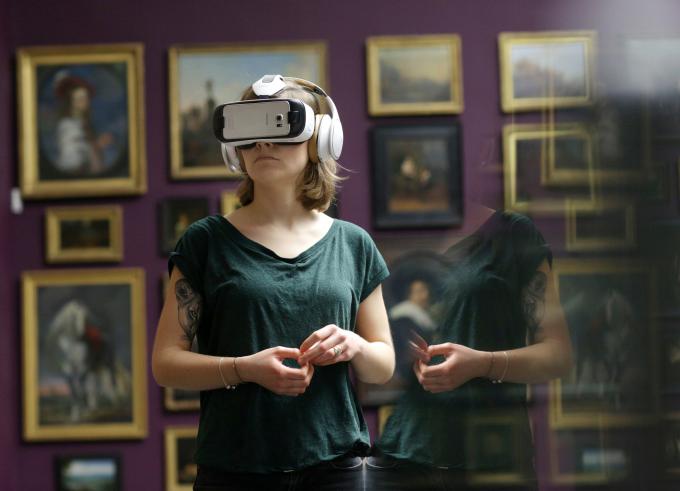
 28.03.2024: KOLLWITZ | Jetzt im STÄDEL MUSEUM
28.03.2024: KOLLWITZ | Jetzt im STÄDEL MUSEUM
 16.02.2024: Gastkommentar: Kunst & Demographischer Wandel mit Wirtschaftswissenschaftler Axel Börsch-Supan
16.02.2024: Gastkommentar: Kunst & Demographischer Wandel mit Wirtschaftswissenschaftler Axel Börsch-Supan
 08.02.2024: Honoré Daumier. Die Sammlung Hellwig | Jetzt im STÄDEL MUSEUM
08.02.2024: Honoré Daumier. Die Sammlung Hellwig | Jetzt im STÄDEL MUSEUM
 26.01.2024: Was bewegt Miron Schmückle?
26.01.2024: Was bewegt Miron Schmückle?
 24.11.2023: Holbein und die Renaissance im Norden
24.11.2023: Holbein und die Renaissance im Norden
 28.09.2023: Gastkommentar: Kunst & Schwarze Löcher mit Astrophysikerin Silke Britzen
28.09.2023: Gastkommentar: Kunst & Schwarze Löcher mit Astrophysikerin Silke Britzen
 18.08.2023: Gastkommentar: Musik im Bild mit Musikwissenschaftlerin Melanie Wald-Fuhrmann
18.08.2023: Gastkommentar: Musik im Bild mit Musikwissenschaftlerin Melanie Wald-Fuhrmann
 05.08.2023: Kunst nach 1945: Gabriele Stötzer
05.08.2023: Kunst nach 1945: Gabriele Stötzer
 11.07.2023: Marc Brandenburg x BMW iX1
11.07.2023: Marc Brandenburg x BMW iX1
 27.06.2023: Was bewegt Philipp Fürhofer?
27.06.2023: Was bewegt Philipp Fürhofer?

